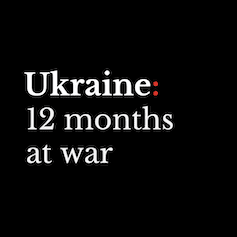As Vladimir Putin steps back from his state of the nation speech, it’s important to note that the Russian government has still not formally declared war on Ukraine. But from a Ukrainian and western viewpoint, we can all see that a war is taking place. This apparent contradiction does matter. What the conflict is called matters for the future progress of the war, and for how the fighting might escalate to include other countries. It also matters for Russia’s domestic politics, and how Putin is able to maintain the morale and fighting will of the Russian people.
All governments in the Euro-Atlantic area (which includes the EU, UK, Canada and the US) describe the conflict in Ukraine as a war of aggression. In contrast, Russia has described its military actions as a “special military operation”. Putin described the conflict in his 21st February state of the nation address as a defensive action to protect Russia and Russian speakers from Nato aggressors. This appeals to his domestic audience but also to other nations who have historically rejected western colonial rule, such as China, India and South Africa, three countries that haven’t criticised Russia’s invasion of Ukraine.
Since Vladimir Putin sent his war machine into Ukraine on February 24 2022, The Conversation has called upon some of the leading experts in international security, geopolitics and military tactics to help our readers understand the big issues. You can also subscribe to our weekly recap of expert analysis of the Ukraine conflict.
Why not declare war?
For the Russian government, the positioning of this as a defensive action, in the state of the nation speech, stops short of it being a declared war. A full declaration of war would allow for for a greater level of conscription, and for diverting more resource towards the military campaign. However, Russia has already invested heavily in the war, with all of its impact on the Russian economy and oligarch wealth, as well as its connectivity with the wider world being restricted after many countries cut flights to Russian cities.
The Russian military frames “levels” of war, which describe the geography of a conflict, and what sort of fighting is taking place. Former senior Russian policy figures have expanded these levels of war to include 17 rungs of escalation, and it is instructive to see where the conflict currently sits in both the levels and on the rungs.
The levels of war Russia uses are:
- armed conflict, which is limited and is between opposing sides within a single territory
- a local war, which is the use of military tools to pursue military and political goals exclusively within the territory of the warring sides and where the interest being fought over are also between those sides
- regional war, which is a conflict including more than two states from the same region pursuing strategically important objectives
- large-scale war, which is war between coalitions of warring parties or world powers such as the US v Russia. In large-scale conflicts, there is a wide spread mobilisation of the resources of the participating states, and can be an escalation from a smaller conflict.
Read more:
Russia pulls out of New Start nuclear treaty – we’ve already seen how such agreements have limited aggression against Ukraine
On the 17-rung scale, hybrid warfare appears as rung four, and includes the use of special forces, mercenaries, economic measures and information and psychological conflict. The annexation of Crimea by Russia in 2014 fitted this pattern. According to Russian logic, the invasion of Ukraine was intended to be a contained local war. It would be characterised by the use of precision and conventional weapons. According to this Russian way of war, regional war appears between the 7th and 11th rung and is typified by extensive conventional strikes. Regional war is judged to be the tipping point towards confrontation between great powers. Russia has, since the summer of 2022, skirted with higher rungs through targeting civilian infrastructure with long range precision weapons (rung 10), and attacking large cities (rung 11).
So, the logic of the Russian position is to try and secure their political and military goals at the lowest level of war, with the least potential for escalation. While there have been concerns that the Ukrainian conflict might result in significant escalation to a major war or nuclear exchange, the Russian position appears to be aimed at keeping the conflict at the level of a local war. Russia has, though, selectively employed some of the tactics identified from higher points in their ladder of escalation.
Formally declaring war on Ukraine would reduce Russia’s ability to manage the response of western powers. Nato and European powers similarly do not wish to be dragged into deploying their own armed forces in Ukraine. Only when both sides no longer see advantage in fighting will talks commence. The fiction of there being no “formal” war in Ukraine might seem ridiculous. It has not stopped Russia from mobilising large numbers of conscripts and diverting resource to their war effort. But it potentially acts as a circuit breaker on a wider international conflict.
![]()
Robert M. Dover does not work for, consult, own shares in or receive funding from any company or organisation that would benefit from this article, and has disclosed no relevant affiliations beyond their academic appointment.











